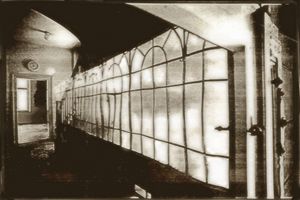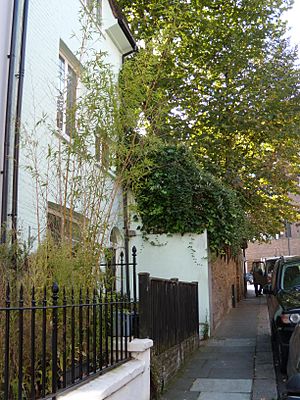Anna Kavan facts for kids
Quick facts for kids
Anna Kavan
|
|
|---|---|
| Born | Helen Emily Woods 10 April 1901 Cannes, France |
| Died | 5 December 1968 (aged 67) London, England |
| Pen name |
|
| Occupation | |
| Nationality | British |
| Notable works | Ice |
| Spouse |
|
| Children | 2 |
Anna Kavan (born Helen Emily Woods; 10 April 1901 – 5 December 1968) was a British novelist, short story writer and painter. Originally publishing under her first married name, Helen Ferguson, she adopted the name Anna Kavan in 1939, not only as a pen name but as her legal identity.
Contents
Biography
Early life
Anna Kavan was born Helen Emily Woods in Cannes, South of France, the only child of a wealthy British family. Her parents travelled frequently and Kavan grew up in Europe and the United States. As an adult she remembered her childhood as lonely and neglected. ..... After his death, Kavan returned to the UK where she was a boarder at Parsons Mead School in Ashstead and Malvern College in Worcestershire.
Disregarding her daughter's desire to go to Oxford, her mother arranged an encounter with Donald Ferguson, her mother's former lover. Helen Emily Woods married him in 1920, a few months before he took a position with the Railway Company in Burma. She moved with her husband, began to write and gave birth to her son Bryan. In 1923, Kavan left Ferguson and returned with her son to the UK. These biographical events match the underlying narrative of her initial Bildungsroman Let Me Alone (1930) while Who Are You? (1963), written in a Nouveau Roman style, is an experimental variation of her time in Burma.
Living alone in London during the mid-1920s, she began studying painting at the London Central School of Arts and Crafts, and continued to paint throughout her life. .....
In 1928 she divorced Ferguson and married an artist named Stuart Edmonds whom she had met near Toulon. They travelled together through France, Italy, Spain and the Pyrenees before resettling in England. A year later, she published her first novel, A Charmed Circle, under the name Helen Ferguson, followed by five more books over the next eight years.
Kavan and Edmonds had a daughter, Margaret, who died soon after childbirth and they then adopted a child whom they named Susanna. .....
As Anna Kavan
Asylum Piece (1940), a collection of short stories which explored the inner mindscape of the psychological explorer, was her first book under the name Anna Kavan, heroine of her previous novels Let Me Alone (1930) and A Stranger Still (1935). All subsequent works would feature a radically altered writing style. From that moment, the brunette Ferguson disappeared and the crystal-blond Kavan set about a career as an avant-garde writer using her legal name in the United States.
An inveterate traveller, Kavan initiated a long journey at the outset of World War II. From September 1939 to February 1943, she spent six months in Carmel-by-the-Sea, California in 1940. The stay inspired her novella, My Soul in China, published posthumously in 1975. She also visited the island of Bali, Indonesia, and stayed for twenty-two months in Napier, New Zealand, her final destination. Her travel itinerary was complicated by the war, which severely restricted many ordinary boat routes. As a consequence, her path took her through New York City three times and the Suez Canal twice.
Returning to England early 1943, she worked briefly with soldiers suffering from war neurosis at the Mill Hill Emergency Hospital and studied for a diploma in Psychological Medicine. She also took a secretarial position at Horizon, an influential literary magazine edited by Cyril Connolly and founded by Peter Watson, one of her friends. She contributed with stories, articles and reviews from 1944 to 1946.
In February 1944, Kavan's son from her first marriage, Bryan Gratney Ferguson, died serving in No. 3 Commando during the Second World War.
After her return to the UK, Kavan began treatment with the German psychiatrist Karl Theodor Bluth. He became Kavan's close friend and sometime creative collaborator until his death in 1964. They co-wrote The Horse's Tale (1949) and Kavan dedicated several short stories to her doctor published in the posthumous collection Julia and the Bazooka (1970). It was Bluth who arranged for Kavan to be treated at Sanatorium Bellevue, a modern clinic where important psychiatric advances were made (1857–1980). There, Kavan received treatment from Ludwig Binswanger, a psychiatrist, pioneer in the field of existential psychology and lifelong friend of Freud.
..... She enjoyed a late triumph in 1967 with her novel Ice, inspired by her time in New Zealand and the country's proximity to the inhospitable frozen landscape of Antarctica. The original manuscript was titled The Cold World. When her publisher Peter Owen sent Kavan his initial response, neither rejecting nor accepting her text, he described it as a cross between Kafka and The Avengers. This post-apocalyptic novel brought critical acclaim. It is her best-known novel, still puzzling the reader for its strangeness and nowadays rather introduced as a slipstream novel than a science fiction one.
The first six of her novels gave little indication of the experimental and disturbing nature of her later work published after her detox treatment. Asylum Piece definitely heralded the new style and content of Kavan's writing. Her development of "nocturnal language". involved the lexicon of dreams and addiction, mental instability and alienation. She has been compared to Djuna Barnes, Virginia Woolf, and Sylvia Plath. Brian Aldiss described her as Kafka's sister. Anaïs Nin was an admirer and unsuccessfully pursued a correspondence with Kavan.
Death and legacy
..... The previous night she had failed to attend a reception in honor of Anaïs Nin at the home of her London-based publisher Peter Owen.
Many of her works were published posthumously, some edited by her friend and legatee, the Welsh writer Rhys Davies. London-based Peter Owen Publishers have been long-serving advocates of Kavan's work and continue to keep her work in print. Doris Lessing, J. G. Ballard, Anaïs Nin, Jean Rhys, Brian Aldiss, Christopher Priest, Nina Allan, Virginia Ironside and Maggie Gee are among the writers who have praised her work.
In 2009 the Anna Kavan Society was founded in London with the aim of encouraging wider readership and increasing academic scholarship of Kavan's work.
Kavan's paintings have been recently exhibited at the Zarrow Art Center in Tulsa, Oklahoma. The Unconventional Anna Kavan: Works on Paper exhibition displayed thirty-six paintings created by Kavan drawn from the McFarlin Library Special Collections, University of Tulsa. The exhibition Mad, Bad and Sad: Women and the Mind Doctors at Freud Museum London traced key moments in the history of hysteria and counterpointed these with women's inventive art.
Influences
Literature
Kavan was friends with the Welsh writer Rhys Davies, who based his 1975 novel Honeysuckle Girl on her early life.
Theater and performance
Choreographer and stage director, François Verret [fr] adapted Ice for the theater in 2008.
Silverglass by DJ Britton is a play about the relationship between Rhys Davies and Anna Kavan. It was presented as a premiere during the Rhys Davies Short Story Conference 2013 held in Swansea. The play is set in the late 1960s and depicts Davies' late literary recognition as well as Kavan's final tragedy. .....
Music and sound art
Thalia Zedek is an American singer and guitarist, active since the early 1980s and member of several notable alternative rock groups, including Live Skull and Uzi. 'Sleep Has His House was the inspiration for the album Sleep Asylum of Uzi' released in 1986.
David Tibet, the primary creative force behind the experimental music/neofolk music group Current 93, named the group's album Sleep Has His House after Anna Kavan's book of the same title.
San Francisco post-rock band Carta titled a song Kavan on their album "The Glass Bottom Boat" after Anna Kavan. The song was subsequently released as a remix by The Declining Winter on their album Haunt the Upper Hallways.
Floriane Pochon, French artist, created a sound artwork untitled Ice Lady based on the novel Ice. It was presented during Les Nuits de la Phaune, a live broadcast event initiated by the Marseille-based Radio Grenouille [fr] in 2008.
Visual arts
In an installation named Anna, the Wales-based artist duo Heather and Ivan Morison investigate the construction of the self based on ambiguous narratives. They developed an allegorical piece of object theatre draws on the life and works of Kavan using performance and puppetry to connect the objects and play out "a brutal tale of love and loss set against the approaching threat of the ice". It has been first presented in 2012 at The Hepworth Wakefield in Wakefield, England.
Further sources
Biographies
- The Case of Anna Kavan : A Biography, by David Callard. London: Peter Owen, 1994
- A Stranger on Earth: The Life and Work of Anna Kavan, by Jeremy Reed. London: Peter Owen, 2006
- Anna Kavan's New-Zealand, by Jennifer Sturm. Auckland: Random House Books, 2009
- Stranger Still: The Works of Anna Kavan, by Francis Booth. London:Lulu.com, 2013
Major archives
The largest collection of archival material from Kavan is held by the University of Tulsa's McFarlin Library, Department of Special Collections and University Archives. This includes her personal archive of manuscripts and artwork in the Anna Kavan papers, 1867–1991; further material in the Meic Stephens collection of Anna Kavan ephemera, 1943–1971; the Richard R. Centing collection of Anna Kavan, 1943–1991; David A. Callard collection of Anna Kavan; and the Anais Nin papers, 1969–1992. Other collections beyond Tulsa include The Peter Owen Archives at the Harry Ransom Center, University of Texas with correspondence between Kavan and her publisher Peter Owen and related material. Other archives contain letters from Kavan to publishers include the William A Bradley Literary Agency, Francis Henry King, Scorpion Press, John Lehmann, Kay Dick and Gerald Hamilton.
Letters from Kavan and papers relating to posthumous publication are included in the Rhys Davis Archive in the National Library of Wales. Letters from Kavan to Walter Ian Hamilton Papers between 1940 and 1955 are in the Alexander Turnbull Library, National Library of New Zealand. Other correspondence can be found at the Jonathan Cape files in the Random House Archives at the University of Reading and the Koestler Archive in Edinburgh University Library, Special Collections.
See also
 In Spanish: Anna Kavan para niños
In Spanish: Anna Kavan para niños
- Modernism
- Women's Writing
- Autobiographical novel
- Nonlinear narrative



